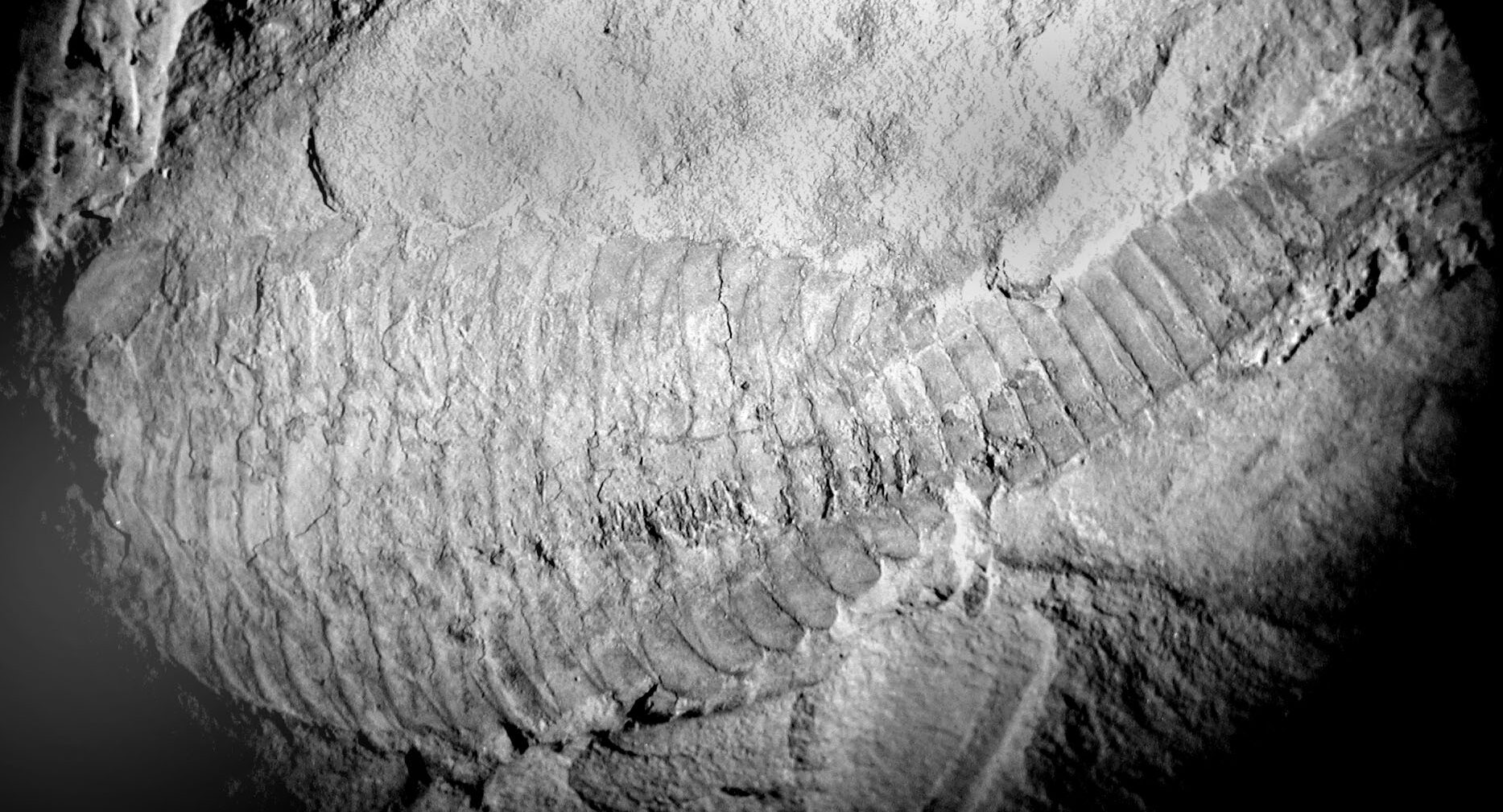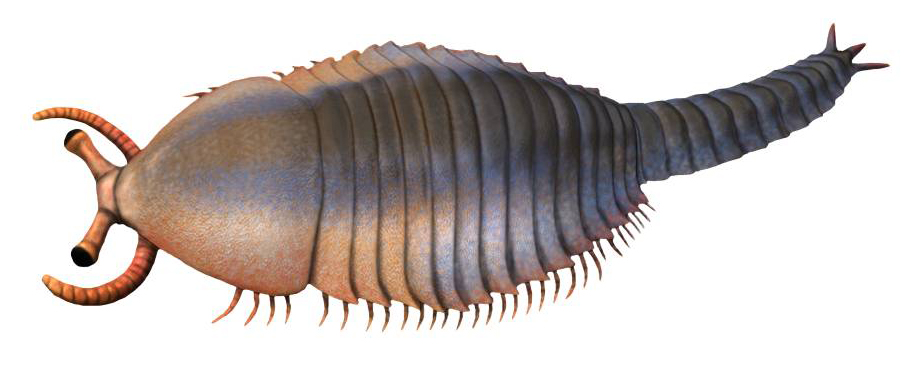Chapter contents:
Arthropoda
–– 1. Stem-group Arthropods ←
–– 2. Trilobita
–– 3. Chelicerata
–– 4. Mandibulata
Above image: A reconstruction of the radiodont, Anomalocaris canadensis, from the Middle Cambrian. Image by Matteo De Stefano (MUSE - Museo delle Scienze); Creative Commons Attribution-Share Alike 3.0 Unported license.
Overview
The phylum Arthropoda includes numerous completely extinct groups that are phylogenetically basal to all extant arthropods. These extinct groups are therefore stem-group Arthropods. Their relationships to one another, as well as the to extant clades of arthropods, vary with individual analyses; recent papers by Daley et al. (2018) and Giribet and Edgecombe (2019) present several of the major competing hypotheses. Examples of some of these stem-group arthropods—many of which have been characterized as "weird wonders" of the Cambrian radiation in books like Stephen Jay Gould's (1989) Wonderful Life—are introduced below.

"Panarthropod fossils from the Burgess Shale. (A) Lobopodian Aysheaia pedunculata, USNM 83942. (B–E) Lower stem group euarthropods. (B) Opabinia regalis, USNM 155600. (C–E) Radiodont fossils. (C) Hurdia mouthpart, USNM 368583. (D) Anomalocaris canadensis body fossil, GSC 75535A. (E) Anomalocaris canadensis from D with musculature (white arrows) and gut glands (black arrows). (F and G) Upper stem group euarthropods. (F) Megacheiran Leanchoilia superlata, USNM 250299. (G) Bivalved arthropod Perspicaris dictynna, USNM 189245. (H–J) Crown euarthropods, artiopodans. (H) Trilobitomorph Helmetia expansa, USNM 83952. (I and J) Vicissicaudates. (I) Sidneyia inexpectans, USNM 250208. (J) Emeraldella brocki, USNM 57702. (Scale bars: 5 mm in A; 10 mm in B–F and H–J; 3 mm in G.)" Figure and caption from Daley et al., 2018 in Proceedings of the National Academy of Sciences (USA) under the PNAS License to Publish (Copyright (2018) National Academy of Sciences).
Lobopodians
Lobopodians are soft-bodied animals known primarily from the Cambrian, and less commonly throughout the Paleozoic. Typically, these animals had tube-like bodies and as many as 25 pairs of legs (see panel A in the figure above for an example). As described by Ortega-Hernández (2015), the simple, straight gut found in many of these animals suggests they were deposit feeders, though some show more derived features for manipulating food (e.g., Hallucigenia) or suspension feeding. Based on their similar appearances, lobopodians have often been considered as stem-group onychophorans (i.e., velvet worms)—a group that is entirely terrestrial today. Alternatively, and in line with recent phylogenetic work (e.g., Giribet and Edgecombe, 2019), lobopodians are now generally thought to form a grade—taxa grouped on morphological similarities rather than ancestor-descendent relationships—that includes early members of all three panarthropod phyla: Tardigrada, Onychophora, and Arthropoda.
Learn more about the history of study of the lobopodian, Hallucigenia, in this video, "Hallucigenia: The worm with the missing head," by Nature Video (YouTube).
Opabinia
The description “weird wonders” is apt for many of the Cambrian fauna, not least of all Opabinia. Opabinia had a cluster of five eyes on the top of their head and a trunk-like appendage that is often reconstructed extending in front of the animal (see reconstruction below). Due to its strange appearance, the phylogenetic placement of Opabinia has been a contentious subject in the scientific literature. Morphologically, Opabinia has vague similarities to the anomalocarids (learn more about this group below), like a flattened, lobed body plan. Based on this body plan, Opabinia are often reconstructed with the capacity for active swimming, using the trunk-like appendage to forage for food. Recent phylogenetic placements (e.g., Daley et al. 2018), such as followed here, include Opabinia as a stem-group arthropod, diverging from the arthropod lineage prior to the evolution of more characteristically arthropodan characteristics, such as seen in many of the groups discussed below.
Watch as a reconstructed Opabinia regalis moves through the Cambrian ocean in this video, "Opabinia regalis model," by Paleozoo (YouTube).
Radiodonta
Radiodonts were prominent, ecologically important members of early Paleozoic ecosystems, especially during the Cambrian. This group includes the commonly known Burgess Shale animals, Anomalocaris. More than two dozen radiodont species have been described from around the world, ranging temporally from the early Cambrian and likely into the Early Devonian. During this time, these animals were the top predators in the oceans. While most other animals were small (i.e., a few centimeters long) and lived on the seafloor, radiodonts were active swimmers and commonly 30 to 60 centimeters in length, with some species reaching sizes up to two meters. Not all radiodonts were top predators; however, as recent discoveries have revealed specialized appendages suited for other feeding strategies, like filter feeding (learn more about these animals in the video below).
"When Giant 'Shrimps' Ruled the Earth" Ben G. Thomas (YouTube).
These animals are often regarded as “weird wonders,” but closer examination reveals many similarities with modern arthropods. For example, the frontal appendages of the anomalocarid radiodonts exhibit characteristics we now associate with arthropods, like skeletonized, jointed segments. Likewise, the compound eyes of Anomalocaris resembled those of living arthropods—and were likely well-suited to a predatory lifestyle. Even so, other non-arthropod features, such as a soft body, mean these enigmatic animals were stem-group arthropods.
Fuxianhuiida
Fuxianhuiids are stem-group arthropods known exclusively from South China. Eight species have been described, all occurring between 520 and 514 million years ago. Originally interpreted as detritus-feeders, recent analyses have suggested they may have been active scavengers, or even predators. Though they are limited in temporal and spatial distribution, fuxianhuiids have provided important insights on the early evolution of arthropods. As discussed by Ortega-Hernández et al. (2018), these early arthropods already had bodies composed of numerous segments, a hardened and jointed exoskeleton, a segmented head, stalked eyes, and specialized appendages (see images below).

A fossil of Fuxianhuia protensa. Image by Grahbudd (public domain).

A reconstruction of Fuxianhuia protensa. Image by Nobu Tamura; Creative Commons Attribution-Share Alike 4.0 International license.
References and Further Reading
Briggs, D. E. 2015. Extraordinary fossils reveal the nature of Cambrian life: a commentary on Whittington (1975) ‘The enigmatic animal Opabinia regalis, Middle Cambrian, Burgess Shale, British Columbia’. Philosophical Transactions of the Royal Society B: Biological Sciences, 370: 20140313.
Budd, G. E., and A. C. Daley. 2012. The lobes and lobopods of Opabinia regalis from the middle Cambrian Burgess Shale. Lethaia, 45: 83-95.
Cong, P., A. C. Daley, G. D. Edgecombe, X. Hou, and A. Chen. 2016. Morphology of the radiodontan Lyrarapax from the early Cambrian Chengjiang biota. Journal of Paleontology, 90: 663-671.
Daley, A. C. 2013. Anomalocaridids. Current Biology, 23: R860-R861.
Daley, A. C., J. B. Antcliffe, H. B. Drage, and S. Pates. 2018. Early fossil record of Euarthropoda and the Cambrian Explosion. Proceedings of the National Academy of Sciences of the United States of America 115(21): 5323-5331.
Giribet, G., and G. D. Edgecombe. 2019. The phylogeny and evolutionary history of arthropods. Current Biology 29: R592-R602.
Ortega-Hernández, J. 2015. Lobopodians. Current Biology, 25: R873-R875.
Ortega-Hernández, J., J. Yang, and X. G. Zhang. 2018. Fuxianhuiids. Current Biology, 28: R724-R725.
Usage
Unless otherwise indicated, the written and visual content on this page is licensed under a Creative Commons Attribution-NonCommercial-Share Alike 4.0 International License. This page was written by Jansen A. Smith and Jonathan R. Hendricks. See captions of individual images for attributions. See original source material for licenses associated with video and/or 3D model content.




